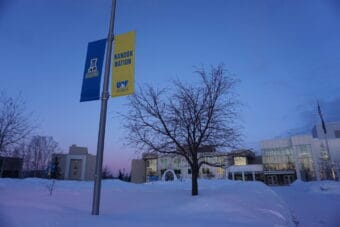
What’s in a name? For the council given the responsibility of safeguarding Alaska’s Indigenous languages, a name change could reflect a broader purpose.
Under legislation pending in the state House, House Bill 26, the Alaska Native Language Preservation and Advisory Council would be renamed to sometime more general: the Alaska Native Language Council.
It might seem a simple change, but it’s meaningful, said the bill’s sponsor, Rep. Andi Story, D-Juneau, one of two legislators who are non-voting members of the council.
The shortened name “better reflects the broad and vital work the council does,” Story said on Monday during a hearing of the House Tribal Affairs Special Committee.
In a committee hearing last Wednesday, X̱’unei Lance Twitchell, the council’s chair, gave a more detailed explanation of the desired name change.
“Preservation is a term that is important to the work that we do, but it only involves documenting the language so we can hold onto the knowledge and the ability of current speakers,” said Twitchell, who is an author and a professor of Alaska Native languages at the University of Alaska Southeast. “Revitalization is also what we do, which involves, in my mind, two things: one, protecting the speakers that you have while creating new ones, and two, ensuring that our languages are languages of power and use. Reclamation is also what we do, which is making sure that our languages are used in a wide variety of social and physical spaces.”
Also speaking in favor of the name change was Walkie Charles, director of the Alaska Native Language Center at the University of Alaska Fairbanks.

“Changing it to Council for Alaska Native Languages provides a clear and understandable title for every Alaskan to recognize, especially our language bearers on whom we rely to sustain and maintain all our languages of Alaska,” Charles said in testimony on Monday. “Keeping it simple benefits all of Alaska in recognizing what the council does and what the council does for all our languages.”
Another provision of the bill would expand the council to seven voting members from the current five. Story said that is important to securing “more breadth of experience” with Alaska’s 23 Indigenous languages.
A bill signed into law in 2014 recognized 20 Indigenous languages as official in Alaska, but that list inadvertently omitted three languages, Twitchell said in testimony Wednesday.
A pending amendment to House Bill 26 – yet to be submitted – would fill out the list to the full 23 languages.
Recognized as official Alaska languages since 2014 are Inupiaq, Siberian Yupik, Central Alaskan Yup’ik, Alutiiq, Unangax, Dena’ina, Deg Xinag, Holikachuk, Koyukon, Upper Kuskokwim, Gwich’in, Tanana, Upper Tanana, Tanacross, Hän, Ahtna, Eyak, Tlingit, Haida and Tsimshian.
The pending amendment would break the Dene languages currently grouped together as “Tanana” into two, the Benhti Kokhwt’ana Kenaga’, or Lower Tanana, and Sahcheeg xut’een xneege’, or Middle Tanana, said Miranda Worl, a staffer for Story. The amendment would also add Cup’ig, currently listed as a subset of Central Alaskan Yup’ik, and Wetał, a language also called Ts’etsa’ut, she said.
This story originally appeared in the Alaska Beacon and is republished here with permission.



